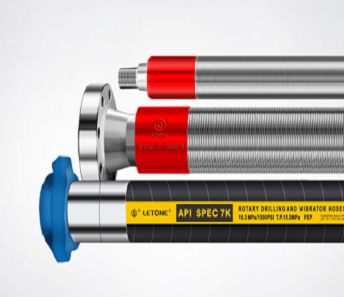How to accurately select suitable wire wound hoses? These core elements must be known
Hydraulic hose assemblies have an indispensable position in the modern machinery industry. They are not only used to transmit oil, gas and other fluids, but also play a key role in ensuring the normal operation of machines. Therefore, the production of high-quality hydraulic hose assemblies requires advanced process technology, strict quality control and comprehensive testing methods. This article will explore the production process, quality control and testing methods of hydraulic hose assemblies in depth to help readers understand the basic knowledge and latest development trends in this field.
1. Production process of hydraulic hose assemblies
The production of hydraulic hose assemblies involves multiple key process steps, each of which is crucial to the final quality of the product.
1. Material selection
The material selection of hydraulic hoses is the primary factor in ensuring their performance. High-quality hose materials usually include synthetic rubber, polyurethane and special polymers. These materials need to have excellent pressure resistance, wear resistance, heat resistance and corrosion resistance. In addition, choosing the right reinforcement layer material, such as steel wire braiding or spiral steel wire, can effectively enhance the pressure resistance of the hose.
2. Hose manufacturing
The manufacturing process of hoses is generally divided into two categories: extrusion molding and winding molding. Extrusion molding is a common process that uses an extruder to process a continuous hose structure. Winding molding is to wrap the reinforcement material around the hose substrate at multiple levels to increase strength. These two methods have their own advantages and disadvantages, and should be selected according to the specific use environment and pressure requirements.
3. Joint installation
The selection and installation of joints are the key links in the processing of hydraulic hose assemblies. The joint installation process mainly includes two methods: ring crimping and sleeve crimping. No matter which method is used, it is necessary to ensure that the joint and the hose are tightly combined to avoid loosening and leakage during use.
4. Gluing and vulcanization
After the joint installation is completed, the hose should be glued and vulcanized. The gluing process ensures a firm connection between the joint and the hose, while vulcanization can improve the oil resistance and wear resistance of the hose. This step plays a key role in improving the durability of the hose.
2. Quality control measures
In order to ensure the quality of the hydraulic hose assembly, strict quality control measures must be implemented during the production process.
1. Raw material quality inspection
Strict raw material warehousing inspection is the first step in quality control. Including the elasticity and heat resistance of rubber materials and the tensile strength of reinforcing materials. Each batch of materials must be quality assessed before entering the factory to ensure that it meets the production standards.
2. Production process monitoring
During the production process, various production indicators need to be strictly monitored, such as the thickness of the hose's rubber layer, braiding density and vulcanization time. By introducing automated processing equipment, real-time monitoring can be achieved during the production process to reduce human operation errors.
3. Finished product testing
Before the product leaves the factory, the hydraulic hose assembly needs to be fully functionally tested. The test content includes pressure test, burst test and durability test. In particular, the pressure test requires testing under conditions higher than the working pressure to ensure the safety and reliability of the product.
4. Quality certification and standardization
Quality certification of hoses in accordance with international standards such as ISO, SAE or DIN is an effective way to enhance product competitiveness. These standards cover the specifications, dimensions, performance and scope of use of the product, providing users with reliable quality assurance.
As an important part of modern mechanical systems, the production process and quality control of hydraulic hose assemblies are complex and sophisticated. Only by rationally selecting production materials, adopting advanced manufacturing processes and strict quality control measures can it be guaranteed to operate stably under high pressure and harsh conditions. At the same time, by introducing advanced testing methods, we ensure that every product meets the highest quality standards. We believe that with the continuous advancement of technology, the production efficiency and product performance of hydraulic hose assemblies will be further improved, providing more reliable solutions for various industrial applications.

 English
English Turkish
Turkish Dutch
Dutch Greek
Greek English
English






